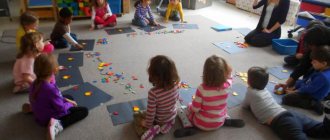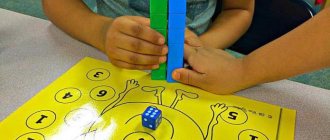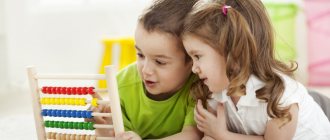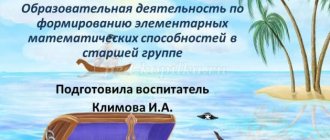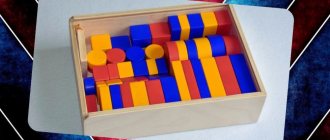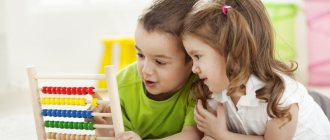Pedagogical project on the topic: “Mathematics is interesting”
- February 12, 2018
International and All-Russian competitions
All-Russian conference “Pedagogical project in a preschool educational institution”
Explanatory note for the project “Mathematics is interesting!”
Relevance of the project
Mathematics is a powerful factor in the intellectual development of a child, the formation of his cognitive and creative abilities. It is also known that the success of teaching mathematics in primary school mathematical .
Mathematics for children is most important in terms of memory development and further perception of mathematical information . For a more effective introduction of mathematics into the child’s mind , its study should, of course, begin in kindergarten. Moreover, you don’t have to be afraid of serious geometric shapes and other things. At this age, the child’s brain catches everything down to the smallest detail, and if sometimes the baby does not understand everything, it’s not scary, anyway, some part of the learning process is embedded in his memory, the brain begins to get used to new data. Gradually, after repetitions, the child will easily distinguish geometric shapes and learn to add and subtract.
It is very important in this regard to have the right approach, to work with the child only in a playful way, using the method of games and tips, otherwise strict classes will quickly become a boring time for the child, and he will not want to return to it anymore.
Why do many children find mathematics not only in elementary school, but even now, during the period of preparation for educational activities? Let's try to answer this question and show why generally accepted approaches to the mathematical preparation of a preschool child often do not bring the desired positive results. In modern training programs, important importance is attached to the logical component.
The development of a child’s logical thinking implies the formation of logical techniques of mental activity, as well as the ability to understand and trace the cause-and-effect relationships of phenomena and the ability to build simple conclusions based on cause-and-effect relationships. So that the child does not experience difficulties literally from the first lessons and does not have to learn from scratch, already now, in the preschool period, it is necessary to prepare the child accordingly.
Many parents believe that the main thing in preparing for school is to introduce the child to numbers and teach him to write, count, add and subtract (in fact, this usually results in an attempt to memorize the results of addition and subtraction within 10).
However, when teaching mathematics using textbooks of modern developmental systems, these skills do not help the child in mathematics . The stock of memorized knowledge ends very quickly after a month or two, and the child cannot independently perform the above mental actions on mathematical content , which leads to the appearance of “problems with mathematics .” The relevance of this issue prompted the idea to create the project “Mathematics is interesting!” on mastering children of middle preschool age - the ability to think logically, analyze, develop memory, attention and, most importantly, correctly express their thoughts out loud.
Project goals:
- To contribute to the creation of pedagogical conditions for the development of curiosity in older children, cognitive activity through entertaining developmental material .
- To increase the level of readiness of older preschool children for school.
- To develop the mathematical concepts of children 6-7 years old at an elementary level through the techniques of comparison, generalization, classification, systematization and semantic correlation.
- To promote the formation and development of the simplest logical structures of thinking and mathematical concepts in older preschoolers
Project objectives:
- develop interest in solving cognitive, creative problems, in a variety of intellectual activities;
- develop imaginative and logical thinking, the ability to perceive and display, compare, generalize, classify, modify, etc.;
- develop the ability to establish mathematical connections, patterns, order, the relationship of arithmetic operations, signs and symbols, relationships between parts of the whole, numbers, measurements, etc.;
- develop combinatorial abilities by combining color and shape, development of creative imagination, memory;
- to arouse the desire for a creative process of cognition and the implementation of strict actions according to the algorithm, self-expression in active, interesting, meaningful activities;
- promote the manifestation of children’s research activity in independent mathematical games, in the process of solving problems of various types, the desire to develop the game and search for results with unique, original actions (in their own way, at the level of age capabilities),
- developing interest in games that require mental stress and intellectual effort,
- promote the desire to achieve a positive result, perseverance and resourcefulness,
- formation of basic mathematical concepts and speech skills.
Expected Result:
- Children are active and independent in using mastered methods of cognition (comparing, counting, measuring, ordering) in order to solve practical, problematic problems and transfer them to new conditions.
- Children successfully solve logic problems.
- Show interest in experimentation. They are able to outline successive steps in the development of a situation, follow goals, and choose means.
- Actively involved in classification and series games; offer options; participate in transformation activities.
Methods used:
- Games
- Watching cartoons
- Conversations, quizzes
- Use of fiction
- Consultations for parents
- Creating a math corner in a group
- Demonstration of visual aids
- Presentations
- Application
- Drawing on semolina
Pedagogical project passport
| Structure | Content |
| Subject | “Mathematics is interesting!” |
| Project addressing | Children, teachers and parents of pupils |
| Project Manager | Grushina L.S. - preparatory group teacher Lazarenko N.S. - preparatory group teacher |
| Project participants | Teachers, children, parents |
| Age of pupils | 6-7 years |
| Project Features | By the nature of the product being created: Educational, playful, creative By number of participants: group; Duration: short-term (1 week); By level of contacts: at the level of the educational institution. |
| Objective of the project | — Contribute to the creation of pedagogical conditions for the development of curiosity in older children, cognitive activity through entertaining educational material. — To increase the level of readiness of older preschool children for school. — Develop the mathematical concepts of children 6-7 years old at an elementary level through the techniques of comparison, generalization, classification, systematization and semantic correlation. — To promote the formation and development of the simplest logical structures of thinking and mathematical concepts in older preschoolers. |
| Project objectives | — Develop interest in solving cognitive, creative problems, in a variety of intellectual activities; — Develop imaginative and logical thinking, the ability to perceive and display, compare, generalize, classify, modify, etc.; — Develop the ability to establish mathematical connections, patterns, order, the relationship of arithmetic operations, signs and symbols, relationships between parts of the whole, numbers, measurements, etc.; — Develop combinatorial abilities by combining color and shape, development of creative imagination, memory; — Arouse the desire for a creative process of cognition and the implementation of strict actions according to the algorithm, self-expression in active, interesting, meaningful activities; — To promote the manifestation of children’s research activity in independent mathematical games, in the process of solving problems of various types, the desire to develop the game and search for results through unique, original actions (in their own way, at the level of age capabilities). — Developing interest in games that require mental stress and intellectual effort. — Promote the desire to achieve a positive result, perseverance and resourcefulness. — Formation of basic mathematical concepts and speech skills. |
| Project Resources | Required support: — methodological materials. -fiction: “Three Bears”, “Two Little Bears”, “Twelve Months” by S. Marshak, “Flower - Seven Flowers” by V. Kataev; story by K. Ushinsky “Four Desires”. Memorizing poems about numbers, counting rhymes, riddles about geometric shapes and numbers. — electronic resources (Internet materials). |
| Intended project products | Expected positive results of the project: Products of the teacher’s activity: — Card index of mathematical riddles; graphic dictations by cells; labyrinths; “Entertaining mathematics” (proverbs, sayings, tongue twisters, poems, attention tasks, entertaining questions, logical endings, counting rhymes); Math problems in verse — Albums “Find the differences”, “Right-left, up-down. Orientation in space", "Games with counting sticks", "Didactic games in mathematics" — Summary of the conversation “How people learned to count” — Consultations for parents “Mathematics is interesting!” Memo for parents “Home mathematics: we are together” — Quiz “Guess it” — Didactic games: cut-out pictures “Days of the week and seasons”, “Number houses”, “Count it”, “Repeat the pattern”, “Mathematical scales” — Presentations “Mathematics in the preparatory group”, “Entertaining mathematics” — Creation of a math corner in the group Products of children's activities: -Applique -Drawing Products of parents' activities: — Watching cartoons at home with children “Back in the land of geometry”, “The story of the power of numbers”, “Learning to count from 1 to 20 with the hedgehog Zheka”, “Mathematical quantities” (educational cartoon) — Help from parents in creating didactic games for the group’s math corner. |
Stages of work on the project.
| Stages of work | The content of the work | Expected result |
| First stage: Preparatory Goal: to promote the development of interest in activities Second stage: Main Goal: to contribute to the accumulation of experience and necessary information Third stage Creative Goal: to promote the development, creativity, imagination, necessary practical skills in the artistic and creative activities of children | Introductory conversation with children "How people learned to count" Reading fiction: “Three Bears”, “Two Little Bears”, “Twelve Months” by S. Marshak, “Flower - Seven Flowers” by V. Kataev; story by K. Ushinsky “Four Desires”. Learning poems about numbers, counting rhymes, riddles about geometric shapes and numbers Didactic games: cut-out pictures “Days of the week and seasons”, “Number houses”. Watching cartoons “Island of Errors”, “Tamer of Numbers”. Math games. Guess Quiz Consultations for parents “Mathematics is interesting!” Memo for parents “Home mathematics: we are together.” Presentations “Mathematics in the preparatory group”, “Entertaining mathematics” Didactically games: “Count it”, “Repeat the pattern”, “Mathematical scales”, “Find the differences”, “Right-left, up-down. Orientation in space" Games with counting sticks Evening of entertaining mathematics Creating a math corner in a group Application “Animals from geometric shapes” Drawing geometric shapes on semolina | Summary of the conversation Book exhibition Didactic games: cut-out pictures “Days of the week and seasons”, “Number houses” Album “Didactic games in mathematics” Quiz summary Consultations for parents “Mathematics is interesting!” Memo for parents “Home mathematics: we are together” Presentations “Mathematics in the preparatory group”, “Entertaining mathematics” Didactically games: “Count it”, “Repeat the pattern”, “Mathematical scales” Albums “Find the differences”, “Right-left, up-down. Orientation in space" Album “Games with Counting Sticks” Card file “Entertaining mathematics” (proverbs, sayings, tongue twisters, poems, attention tasks, entertaining questions, logical endings, counting rhymes); "Math problems in verse" Creating a math corner in a group |
MAGAZINE Preschooler.RF
Project on the mathematical development of preschool children: Formation of elementary mathematical concepts in children of the older group using entertaining mathematics(joke tasks, puzzles, intelligence tasks)
Explanatory note.
Relevance of the project.
Adults never cease to be amazed at how much a child can learn and remember in the early years. The period of preschool childhood is short relative to a person’s entire life, but how rich it is in learning! Every day brings the child something new, unknown; something previously inaccessible becomes close and understandable.
The flow of information that the surrounding life brings down on a small person is great. He finds the answer to many questions by going through trial and error, comprehending the laws: you cannot squeeze a voluminous object into a narrow hole; To make the Christmas tree garlands the same, you need to cut equal strips of paper; When treating dolls to tea, you need to put a cup in front of each one... And much, much more.
The source of a preschooler’s knowledge is sensory experience. Its range depends on how finely the child masters the sum of special actions (examining, feeling, comparing, juxtaposing, distinguishing between the main and the secondary, etc.) that influence perception and thinking.
Teaching preschoolers the basics of mathematics is currently given an important place. This is caused by a number of reasons: the beginning of schooling at the age of six, the abundance of information received by the child, increased attention to computerization, the desire to make the learning process more intensive, the desire of parents in this regard, to teach the child to recognize numbers, count, and solve problems as early as possible .
The main goal is being pursued: to raise children as people who can think, navigate well in everything that surrounds them, correctly assess the various situations they encounter in life, and make independent decisions. Adults often rush to give the child a set of ready-made knowledge and judgments, which he absorbs like a sponge. However, does this always give the expected result? For example, should a child be forced to do math if he finds it boring?
The practice of preschool education shows that the success of learning is influenced not only by the content of the material offered, but also by the form of its presentation, which can arouse the child’s interest and cognitive activity.
Entertaining can be provided by an unusual form of learning. You just need to find a middle ground: don’t complicate things—children won’t understand, and don’t simplify things by making learning easier—children will constantly look for easy ways to work less. Receiving food for his mind, the child willingly participates in activities, waits for them, and enjoys them.
Entertaining material not only captivates the child, but also helps improve the preschooler’s observation, attention, memory, thinking and speech skills. Poetic material, riddles, counting rhymes are used depending on the goals of cognitive communication. The possibilities for their use are wide: in group classes in kindergarten, during individual work with children in the family, at quizzes, leisure activities, holidays, during educational conversations, in the toy library, when children receive their parents as guests and play mathematical games with them.
Entertaining mathematics puts preschoolers in search conditions, awakens an interest in winning, therefore, children strive to be fast and resourceful.
The problem to be solved during the implementation of the project.
In the senior group of compensatory orientation there are 13 children: 7 boys and 6 girls.
During classes on the formation of elementary mathematical concepts, many children in the senior group of compensatory orientation lacked interest in mathematics and had difficulties with thinking and attention.
At the beginning of the year, this area was implemented by 1.5 points, which ultimately amounted to 37.5% - a low figure for the group.
In order to increase the level of mathematical development, the activity of children, and develop their interest in mathematics, we decided to use entertaining material: riddles, poems, didactic games, entertaining questions, joke problems, mathematical fairy tales, proverbs and sayings, finger gymnastics, labyrinths, logical endings, mathematical KVNs.
Contingent of project participants: pupils of the senior group of compensatory orientation; educator; parents of pupils.
Project goal: Formation of elementary mathematical concepts in children of senior preschool age through entertaining material.
Tasks:
- To develop interest in mathematics in children of senior preschool age, emotional responsiveness through games with mathematical content.
- Formation of basic mathematical concepts and speech skills.
- To promote the development of mental operations (analysis, synthesis, comparison, classification), logical thinking.
- Develop independence of cognition, encourage manifestations of creative initiative and resourcefulness.
- Increase your attention span and memory.
- Develop speech, the ability to express and justify your opinions;
- Cultivate interest in the subject and the learning process in general.
Contents of the project.
Stage I – preparatory.
- Involve parents in the implementation of the project.
Message: “Educational and educational tasks for the formation of elementary mathematical concepts in the senior group” at a parent meeting.
Individual conversations about diagnostic results.
- Creating conditions for project implementation.
Selection of entertaining material for individual and face-to-face lessons with children, production of gaming mathematical material.
- Primary diagnosis.
- Studying methodological literature on the topic.
- Search for materials on the Internet.
Stage II is the main one.
- Implementation of the main activities in the project areas.
- Presentation of the project is an open lesson on the formation of elementary mathematical concepts for parents.
Stage III – final.
- Carrying out final diagnostics.
- Collection and processing of methodological and practical materials.
- Correlation of predicted results with obtained ones.
- Summarizing project materials.
Expected results.
- positive dynamics of monitoring on the formation of elementary mathematical concepts in children of senior preschool age;
- formation of logical thinking operations (analysis, synthesis, comparison, classification, generalization);
- children’s use of mathematical knowledge and skills in independent activities and manifestations of creative initiative;
- parents’ awareness of the importance of forming elementary mathematical concepts in children with the help of entertaining material, expanding parents’ knowledge about entertaining material;
- developing in children an interest in mathematics and a desire to overcome difficulties.
Project implementation.
The development of attention and intelligence is facilitated by joke tasks and puzzles that warn the child against hasty and unfounded conclusions. They should not be solved like ordinary problems, using one or another arithmetic operation. These tasks should encourage children to reason, think, and find an answer using existing knowledge.
Using joke problems and intelligence tasks will help diversify and enliven activities with children. In addition, tasks of this kind can be used during mathematical leisure activities, fun meetings of preschool experts, and KVNs.
Entertaining material not only entertains children, gives them the opportunity to relax and switch gears, but also makes them think, develops independence and initiative, directs them to search for unconventional solutions, and stimulates the development of non-standard thinking.
Children are given the opportunity to listen carefully to the riddle, remember its content, and guess it. The riddle is told emotionally, slowly.
Children know a lot of counting rhymes and most often use them to choose the leader in games. The same technique can be used in mathematics classes. To increase the activity of children in the classroom, you do not need to assign children, but do it with the help of a counting rhyme.
For the formation of full-fledged mathematical concepts and for the development of cognitive interest in preschoolers, it is very important, along with other methods, to use entertaining problem situations. The fairy tale genre allows you to combine both. The plot itself and fairy-tale characters attract children. By getting used to the events of the fairy tale, the child seems to become its protagonist. At the same time, cognitive activity increases: he strives to intervene in situations and influence them. The keen interest that arises in a child can be used to increase the effectiveness of learning.
Materials for activities with children.
Game "White Sheet" .
Aimed at developing the perception of the shape of objects in children, as well as the development of fine motor skills of the hands.
Figures are drawn on a sheet of paper, some are painted in green, others are only outlined.
TASK: Cut out the figures outlined along the outline from the sheet, and then cover the green figures on another sheet of paper with them. If the shapes are positioned correctly, the result should be a white sheet of paper.
Game "Circle, Triangle, Square"
Aimed at developing the perception of color, shape and size in children.
The child is given tasks aimed at differentiating characteristics of color, size, and shape.
Game “Sew up the carpet”
Designed to develop perception in preschool children.
There were holes in the beautiful rug. There are several patches located near the mat, from which you need to choose only those that will help close the holes.
Working with materials, the child can not only choose, but also cut out the desired patch to close the hole in the carpet.
Problems-joke, puzzles, tasks for intelligence.
1. There were 10 pears growing on the pear tree, and 1 less on the birch tree. How many pears grew on the birch tree? %3
2. There were 6 carrots growing in the garden bed
And on the pine tree there is 1 more carrot.
How many carrots grew on the pine tree?
3. 8 squirrel tails were peeking out of the hollow. How many baby squirrels were sitting in the hollow?
4. The long-awaited winter has arrived. First 1 apple tree bloomed, and then 3 more. How many apple trees bloomed in winter?
(They don’t bloom in winter).
5. A hedgehog walked through the forest and found mushrooms for lunch: 2 under a birch tree, 1 near an aspen tree.
How many will there be in a wicker basket? (Answer: 3)
6. A peacock was sitting in the garden. Another one came up. Two peacocks behind the bushes. How many are there? Do the math for yourself.
(Answer: 4)
7. Come on, how many guys are there skating on the mountain? Three are sitting in a sled, One is waiting.
(Answer: 3)
8. On a large sofa, Tanin’s dolls stand in a row: Two nesting dolls, Pinocchio and a cheerful Chipolino.
Help Tanya count her toys.
(Answer: 4)
Puzzle problems with sticks.
A) From 5 sticks, fold 2 equal triangles
B) Make 2 equal squares from 7 sticks.
Puzzles.
- Seasons, months.
- Days of the week, parts of the day.
- Time watch.
- Numbers.
Counting books.
My family
1. One, two, three, four, Who lives in our apartment? Dad, mom, brother, sister, Murka the cat, two kittens,
My puppy, cricket and me - That's my whole family! One, two, three, four, five, I’ll start counting them all again
2. A jackdaw sat on the fence. The counting begins: one, two, three, four, five! I will count all the guys:
Yulia, Misha, Sveta, Kolya, Petya Ira, Vitya, Olya... If I get tired of counting, I’ll stop for a minute.
I’ll keep quiet, take a break, and start counting again.
3. We have only one red ball - This time. Two green ones, look, - This is two, and this is three.
For four, five and six - Three are blue. Let's throw yellow and pink - This is seven and this is eight.
Blue is nine, white is ten. Where should we hang the balloons? Rainbows are playing in the sky - Kids are counting the balls.
4. The sheep walked along the road and got their feet wet in a puddle. One, two, three, four, five, They began to wipe their feet:
Some with a handkerchief, some with a rag, Some with a holey mitten.
Mathematical tales.
- "Extraordinary adventures in the city of mathematical mysteries".
- “Visiting the gnome watchmaker, or a story about how not to be late for school”.
- "How Top Learned Math".
- "Zhenya's Games".
- “Help Dunno find the way”.
- "Guess yourself!".
- "How Nina taught her brother".
Photographic materials.
Results.
- Positive dynamics of growth in children's mathematical development.
At the beginning of the year, this area was implemented by 1.5 points, which ultimately amounted to 37.5% - a low figure for the group; at the end of the year – 2.3 points (57.4% average).
- Children show cognitive activity, creative initiative, and try to overcome difficulties in joint activities with the teacher and independently.
- Increasing pedagogical literacy and parents' interest in the formation of elementary mathematical concepts in children.
- An entertaining mathematics corner has been created.
- The final lesson “Mathematical Kingdom” for parents.
Literature.
- Nishcheva N.V. GAME. Games and exercises for the formation and development of elementary mathematical concepts and speech in preschoolers. - SPb.: “CHILDHOOD-PRESS” , 2003. – 16 p., ill.
- Erfeeva T.I. and others. Mathematics for preschoolers: Book. For the teacher of children. garden/T. I. Erofeeva, L.N. Pavlova, V.P. Novikova. – M.: Education, 1992. – 191 p.: ill.
- Mathematics from three to seven: Educational and methodological manual for kindergarten teachers / Author. – comp. BEHIND. Mikhailova, E.N. Ioffe; Hood. I.N. Rzhevtseva. – St. Petersburg: “Aktsident” , 1997. – 176 p.: Ill.
- Tikhomirova L.F. Development of children's cognitive abilities. A popular guide for parents and teachers. – Yaroslavl: Academy of Development, 1996. – 192 p., ill.
- L.G. Peterson, E.E. Kochemasova. Playing game. Practical mathematics course for preschoolers. Guidelines. – “Balass” , 1998. – 160 p.
| Next > |

